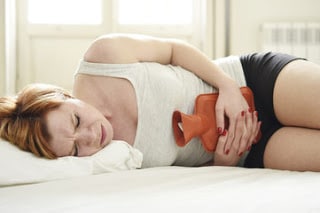The Secret to Reducing the Symptoms of Red Light and Cramps before period

The monthly menstrual cycle is a normal physiological manifestation of the girlfriend, but many of you just want it not to appear, all because of severe pain in the abdomen or cramps when the time comes. This affects the health as well as the life of women. Here are some tips to help you get ahead of cramps before the period.
Back pain
Contractions in the lower abdomen will often make you tired, and even accompanying back pain is very common. Some people just feel pain in the slightest degree, sadness in the back but some people feel pain, aches. Then you should:
- Apply the pain patch to the aching area for about 20 minutes. Then, you peel off and paste another pad after an hour.
- A warm bath helps to relax, relieve stress, and reduce back pain.
- Exercise during the day reduces cramps before the period and back pain. You can walk, do yoga, cycling, stretching exercises, and avoid strong exercise like running, swim.
- Avoid foods high in caffeine, salt, tobacco, and alcohol. A diet rich in vegetables and low in starch helps limit pain.
- Drink chrysanthemum tea, honey ginger tea. Drinking honey ginger tea helps relieve back pain.
- Massage the back with oil or massage with oil for 5 minutes.
Stretch hard, uncomfortable in the chest
On the day of the cycle, the body loses hormonal balance, estrogen levels drop, progesterone increases, causing chest swelling, straining. You should:
- Wearing a bra close to the body and fit. If your bra is tight, you should choose a sports bra.
- Put an ice pack or small hot water bottle into a soft towel and apply around the chest for 20 minutes. Do not apply the source of cold or heat directly up sensitive skin.
- Add 1,000 mg to 1,500 mg of calcium and 500 mg of vitamin E daily.
- On the day of the cycle, the body loses hormonal balance; the estrogen level decreases, progesterone rises, causing chest swelling, tension.
Abdominal pain, flatulence
This can be one of the direct causes of cramps before the period. Flatulence is often caused by eating disorders, but it can also be affected by hormones. Because of the varying levels of estrogen and progesterone in the month, the digestive process also changes. This constant change can lead to flatulence in your stomach.
Eat less salt during the menstrual period. The reason is that salt can hold water and cause bloating, which can lead to cramps. Cook with fresh food, avoiding pre-prepared food.
Reduce processed foods during those days.
Eat more fruits, vegetables 14 days before menstruation. They provide fiber, reducing constipation, which is common in the “red lights” day.
Enhance fish oil: Omega-3 in fish helps reduce prostaglandin production so it can reduce abdominal pain. You should eat tuna, salmon, mackerel, herring, sardines …
Mint tea helps to relax and tighten the numbness. If you have nausea, you should also drink this tea.
Drink plenty of water, lie down, apply hot water bottle, message light belly.
Stress, mental decline
After ovulation, progesterone secretes against the activity of estrogen in the brain. It will make your mood go down, irritated, severely depressed and depressed. Stress is always a bad influence on your condition, especially because it causes cramps before the period. The solution for you:
- Eat foods rich in vitamin A and rich in fiber such as sweet potatoes, gac, kale, and broccoli to support your estrogenic metabolism more efficiently.
- If you are feeling depressed, you should eat foods rich in vitamin B6 (tuna, salmon, cod, liver, garlic, sesame seeds), vitamin B5 (mushrooms, sunflower seeds, cheese, fish, avocados, vitamin B12 (eggs, cheeses, skimmed milk, beef, crab, fish and soy products).
Conclusion
Knowing the rules and treatment when you are in the menstrual period is always necessary. Above is a very clear introduction to the secret to reducing the symptoms of red light and cramps before the period. We hope the menstrual period will not be a problem you have to bother more.
Below is an infographic you can learn from

